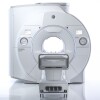Ultrasound Aids Venous Catheterization
by Amanda Doreson, Project Manager | November 20, 2006

Ultrasound is a
low-cost option for
critical-care patients
low-cost option for
critical-care patients
ATHENS, Greece -- For critical-care patients, ultrasound-guided catheterization of the internal jugular vein proved quicker, easier, and safer than the traditional landmark-guided method, found researchers here.
In a prospective randomized controlled trial that compared 450 critical-care patients given ultrasound-guided cannulation with 450 similar landmark-guided patients, cannulation of the internal jugular vein was successful in all the ultrasound patients versus 94.4% of the landmark group (P <0.001), according to an online report in Critical Care.
The real-time ultrasound method was also less likely to result in puncture of an artery or bloodstream infection, said Dimitrios Karakitsos, M.D., of the General State Hospital of Athens, and colleagues in Greece, The Netherlands, and the U.S.
Complications of the landmark-guided technique, in which the needle is passed along the anticipated line of the vein, are influenced by body-mass index, site of attempted access, and operator experience, the researchers said. Furthermore, they said, studies show that inability to cannulate the vessel may occur in up to 19.4% of cases.
Patients in the Athens study were stratified by age, gender, and body mass index. The patients in both groups were comparable in all values pertinent to the procedures, including risk factors for difficult venous cannulation.
The investigators said they believed this was the first time such a controlled comparison has been done between the methods. It is important because no other factors, other than the technique itself, should have affected the results.
The results were:
* The average access time (skin to vein) and number of attempts were significantly reduced in the ultrasound group compared with the landmark group (P<0.001), the investigators reported.
* The ultrasound-guided technique led to few cases of carotid puncture (1%) or hematoma (0.4%), and no cases of hemothorax or pneumothorax.
* Puncture of the carotid artery occurred in 10.6% of the landmark patients, hematoma in 8.4%, hemothorax in 1.7%, and pneumothorax in 2.4%.
* 16% of the landmark patients, had a catheter-associated bloodstream infection versus 10.4% in the ultrasound group (P<0.001).
* In several ultrasound patients in whom carotid puncture occurred, the internal jugular vein overlay the carotid artery rather than being more lateral to it. A sideways approach of puncturing the jugular vein was used instead of the perpendicular approach.
Although in the past the ultrasound method has compared favorably with the landmark technique, its widespread use has been hampered by unavailability of the specially designed ultrasound devices or sterile scanner manipulation, and lack of trained personnel, Dr. Karakitsos said.
In a prospective randomized controlled trial that compared 450 critical-care patients given ultrasound-guided cannulation with 450 similar landmark-guided patients, cannulation of the internal jugular vein was successful in all the ultrasound patients versus 94.4% of the landmark group (P <0.001), according to an online report in Critical Care.
The real-time ultrasound method was also less likely to result in puncture of an artery or bloodstream infection, said Dimitrios Karakitsos, M.D., of the General State Hospital of Athens, and colleagues in Greece, The Netherlands, and the U.S.
Complications of the landmark-guided technique, in which the needle is passed along the anticipated line of the vein, are influenced by body-mass index, site of attempted access, and operator experience, the researchers said. Furthermore, they said, studies show that inability to cannulate the vessel may occur in up to 19.4% of cases.
Patients in the Athens study were stratified by age, gender, and body mass index. The patients in both groups were comparable in all values pertinent to the procedures, including risk factors for difficult venous cannulation.
The investigators said they believed this was the first time such a controlled comparison has been done between the methods. It is important because no other factors, other than the technique itself, should have affected the results.
The results were:
* The average access time (skin to vein) and number of attempts were significantly reduced in the ultrasound group compared with the landmark group (P<0.001), the investigators reported.
* The ultrasound-guided technique led to few cases of carotid puncture (1%) or hematoma (0.4%), and no cases of hemothorax or pneumothorax.
* Puncture of the carotid artery occurred in 10.6% of the landmark patients, hematoma in 8.4%, hemothorax in 1.7%, and pneumothorax in 2.4%.
* 16% of the landmark patients, had a catheter-associated bloodstream infection versus 10.4% in the ultrasound group (P<0.001).
* In several ultrasound patients in whom carotid puncture occurred, the internal jugular vein overlay the carotid artery rather than being more lateral to it. A sideways approach of puncturing the jugular vein was used instead of the perpendicular approach.
Although in the past the ultrasound method has compared favorably with the landmark technique, its widespread use has been hampered by unavailability of the specially designed ultrasound devices or sterile scanner manipulation, and lack of trained personnel, Dr. Karakitsos said.
1(current)









